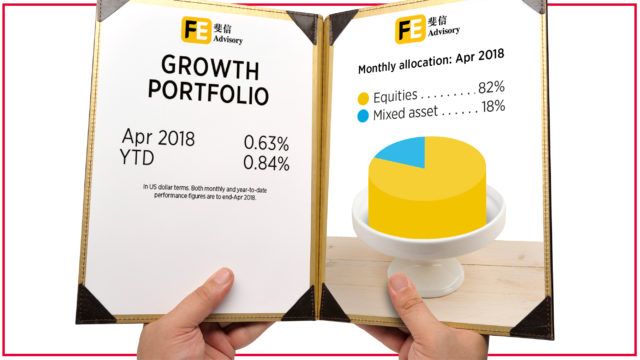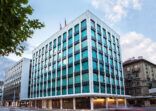Each month we feature the allocation in one of the three portfolios offered by FE Advisory Asia: cautious, balanced and growth. Data is included to show how well the portfolio has done compared to the previous month and year-to-date so that readers can get a sense of performance.
Additionally, Luke Ng, senior VP of research at FE Advisory Asia, provides a concise analysis on macro events and their potential impact on the portfolio.
A breakdown of the Growth portfolio at the end of April 2018.* Performance figures are in the menu image above.


Luke Ng, FE Advisory Asia
How did the market perform in April?
Following the wild swings in the first quarter, equities have somewhat stabilised in April, to return moderate gains, aided by a softening in the protectionist rhetoric and the threat of a trade war. The best performing sector during the month was energy, amid rising tension in the Middle East, which boosted oil price. The sector was further supported by good earnings results announcements by the key US and European energy players. Overall, macroeconomic data continued to show strength. The US announced better than expected GDP growth in the first quarter, and the Eurozone Purchasing Managers’ Index remained at 55.2, suggesting that business activity continued to rise.
Emerging market equities, however, fell slightly in April. The strengthening of the US dollar proved to be a headwind for these markets. Emerging Europe was worse off, as Russia was hit by the new US sanctions and the loss was amplified by a weakening rouble. On the other hand, Asia fared better, with developed economies of the region, including Singapore and Hong Kong, as the frontrunners. Indian equities also recovered well following the market weakness in the first quarter.
Fixed income posted negative returns in the month. US treasury yields moved up at both the short and long ends of the curve as inflation data continued to be a concern. Yields on European government bonds also rose, but to a lesser extent. Local currency emerging market bonds were hit harder on the back of US dollar strength.
How did the Growth portfolio perform?
Our growth portfolio grew 0.63% in April in US dollar terms, faring better than emerging market equities but lagging behind the developed world. The best performing holding in the portfolio was our exposure in the energy sector. This was delivered by the BlackRock GF World Energy, which posted double digit returns in the month. Another holding that also served as a portfolio diversifier was a fund investing in global property equities. On the other hand, our exposure to emerging markets and Japan that were acquired through JP Morgan strategies struggled to make headway in April. Both holdings underperformed their respective markets as their growth-oriented styles proved a drag. It was a month when value investors did considerably better than growth investors in both markets.
FE Advisory Asia portfolio performance
| Jan 2018 | Feb 2018 | Mar 2018 | Apr 2018 | YTD 2018 | |
| Cautious | 1.43% | -1.58% | -0.14% | 0.06% | -0.26% |
| Balanced | 3.64% | -2.68% | -0.80% | 0.44% | 0.49% |
| Growth | 5.19% | -3.60% | -1.17% | 0.63% | 0.84% |


















